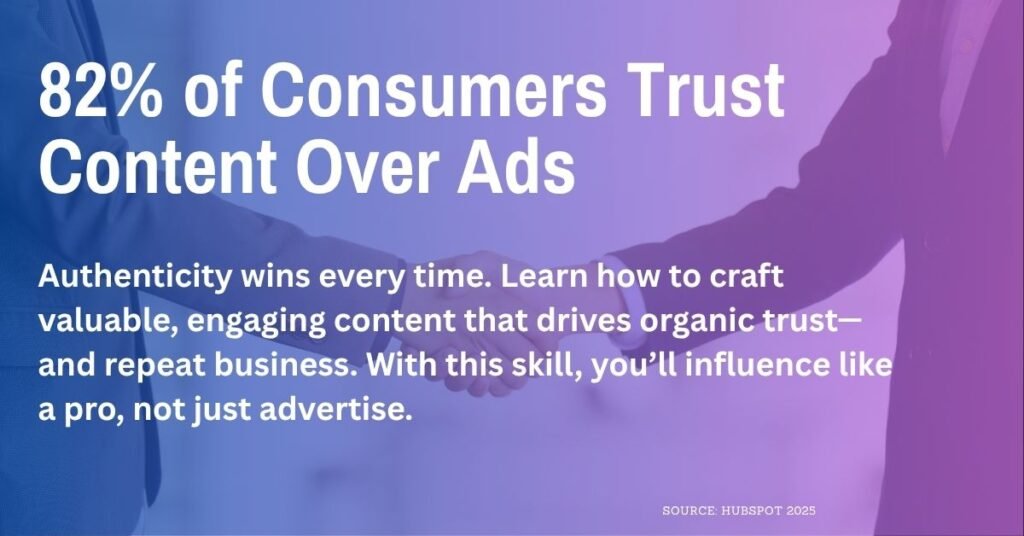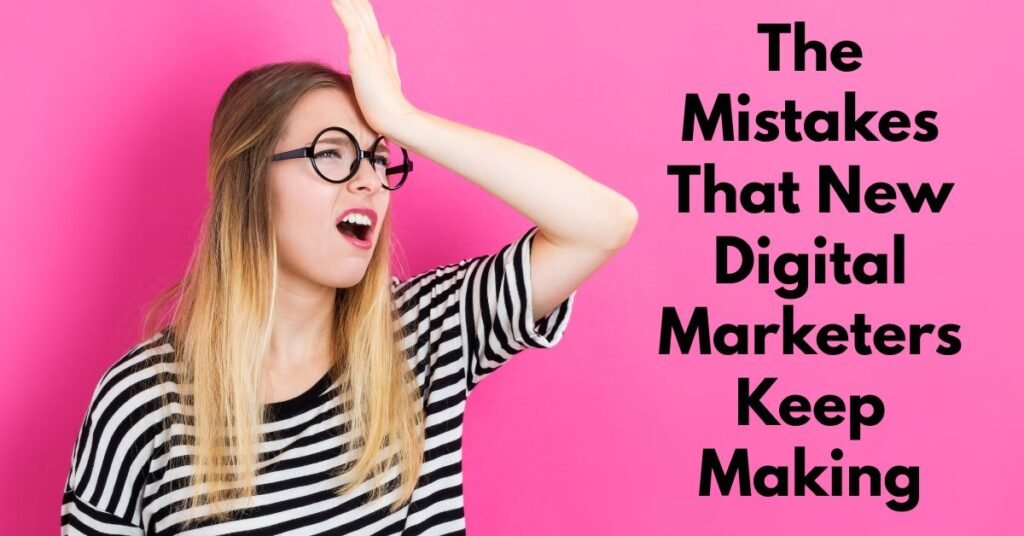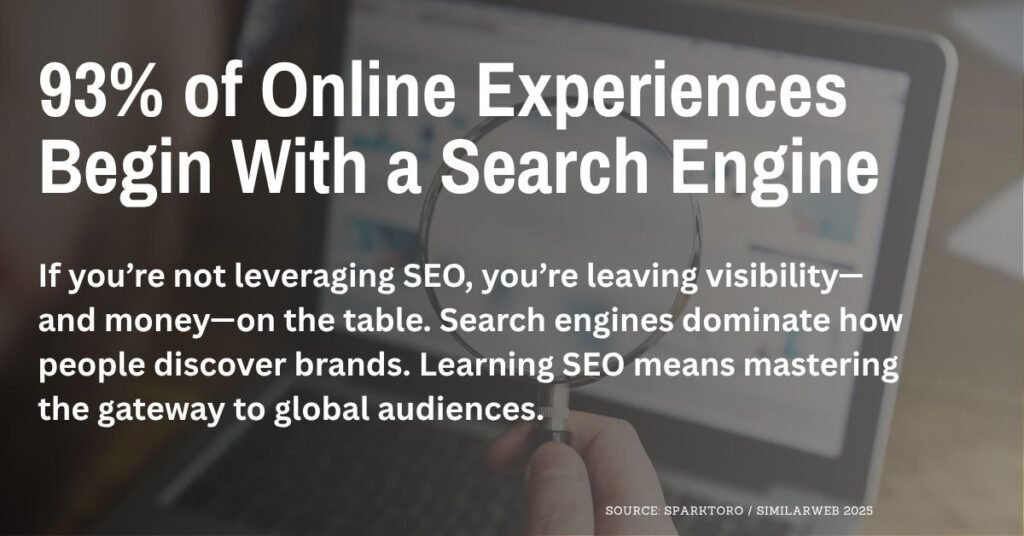Table of Contents
Are you asking yourself the same questions about how to learn digital marketing as below? Good news, you’re in the right place! I’ll discuss these topics and answer them. Be sure to also check the FAQ at the bottom.
- Can I teach myself digital marketing?
- How to start digital marketing as a beginner?
- What are the 4 types of digital marketing?
- How can I learn digital marketing at home?
Let’s not sugarcoat this: if you’re not leveraging digital marketing in today’s landscape, you’re leaving money—and relevance—on the table. It’s not a “nice-to-have” anymore. It’s the battlefield where businesses are made or broken. Whether you’re a scrappy entrepreneur, a scaling startup, or a seasoned business owner wondering how to keep up with the TikToks and ChatGPTs of the world, this guide is for you.
Here’s what we’re tackling: What IS digital marketing, really? Digital marketing is also called online marketing, and it covers a wide range of internet-based channels like search engines, social media, email, and more. How do you cut through the noise of ever-expanding channels and tactics? Digital marketing involves numerous digital tactics to reach and engage customers across these platforms. And most importantly, how can you use it to grow your business starting right now? In this beginner-friendly guide, I’ll walk you through the essentials to go from digital rookie to marketing powerhouse. Expect no-nonsense strategies, bold truths, and actionable tips to help you hit the ground running.
Let’s break it down into four core pillars you need to know to master the basics: What is digital marketing? Why it matters. The biggest mistakes to avoid. And how to create your first winning strategy.

What Is Digital Marketing (and Why It’s Non-Negotiable)
Let’s start with the truth: digital marketing isn’t just “marketing on the internet.” That oversimplifies it. Digital marketing is how businesses leverage online AND offline digital channels—like search engines, social media, email, video, apps, and content—across various digital platforms—to connect with their ideal customers. It’s about creating real-world impact through the power of data-driven storytelling. Digital marketing is also referred to as online marketing.
Unlike traditional marketing—billboards, print ads, radio—and other traditional marketing channels such as print media—digital marketing offers more targeted, measurable, and cost-effective ways to reach audiences.
But let me ask you this: Do you know where your audience spends their time?
Here’s what many forget: Digital marketing isn’t about being everywhere—it’s about being where your audience is. And in 2023, everyone is online.
- 5.18 billion people, or 64.6% of the global population, are internet users (DataReporting, 2023).
- The average person spends over 6 hours a day online.
- 81% of shoppers research a product online before buying, even if that purchase happens in-store.
Much of this time is spent on popular social platforms such as Facebook, Instagram, TikTok, and X, which are key venues for audience engagement and content sharing.
If you’re not showing up in the spaces your customers already occupy, you’re invisible. Period. Your competitors will reach them first, and you’ll be a distant afterthought.

Why is digital marketing a game-changer?
Unlike traditional marketing—billboards, print ads, radio—you’re not guessing whether a campaign worked in the digital experience. Here, every click, scroll, and interaction can be tracked and optimized.
Digital marketing allows you to:
- Target specific audiences (via demographics, interests, behaviors, etc.).
- Track metrics that matter (like ROI, traffic, and customer acquisition costs).
- Use marketing automation to streamline and optimize campaigns, improving efficiency and personalizing customer engagement.
- Scale quickly without a massive upfront budget, using digital ads as a cost-effective way to reach more people.
Bold truth: Digital marketing is the great equalizer. Whether you’re running a Fortune 500 company or a family bookstore, with the right strategy, you can compete on a global scale.

The Real Benefits of Digital Marketing (Why You Can’t Afford to Ignore It)
Let’s get real: digital marketing isn’t just another item on your to-do list—it’s the engine that powers modern business growth. Why? Because digital marketing channels give you superpowers that traditional marketing could only dream of.
With the right digital marketing strategy, you can reach audiences far beyond your local area, tapping into new markets and expanding your brand’s footprint. Unlike old-school marketing, digital marketing lets you zero in on your ideal customers—targeting by age, interests, location, and even online behaviors. This means your marketing efforts are laser-focused, not scattershot.
But here’s where it gets even better: every click, view, and conversion is measurable. You’re not left guessing if your marketing strategy is working. With digital marketing, you can track what’s driving results and double down on what works. This data-driven approach helps you refine your marketing channels, increase brand awareness, and hit your marketing goals faster.
Bottom line? Digital marketing gives you the tools to personalize your message, scale your marketing efforts, and outpace the competition. Ignore it, and you risk falling behind. Embrace it, and you unlock a world of growth.
Reach, Target, Measure, and Grow: The Superpowers of Going Digital
The beauty of digital marketing is in its reach and precision. Social media marketing, search engine optimization (SEO), and other digital marketing tactics allow you to connect with potential customers wherever they are—on their phones, laptops, or tablets. You can craft campaigns that speak directly to your audience’s needs and interests, making every marketing effort count.
And thanks to tools like Google Analytics, you can measure the impact of your digital marketing efforts in real time. Want to know which social media posts are driving traffic? Or which keywords are bringing in the most leads from search engines? It’s all at your fingertips. This level of insight means you can adapt quickly, optimize your campaigns, and keep growing your business.
In today’s digital world, these superpowers aren’t optional—they’re essential. Use them to build your brand, attract potential customers, and stay ahead in the ever-evolving digital marketing landscape.

The Mistakes That New Digital Marketers Keep Making (and Why It Costs Them)
Is digital marketing accessible to everyone? Yes.
Does that mean it’s easy? No.
Here’s where most beginners spin their wheels. They launch a marketing campaign blindly, try to master every trend (looking at you, Threads and AI-generated weirdness), and measure success with vague vanity metrics. A marketing team should coordinate efforts, assign clear roles, and use the right tools to avoid these mistakes. I’ve seen this all too many times, and it frustrates me because these mistakes are completely avoidable.
Mistake 1: Trying to Be on Every Platform
“Do I need to be on every platform?” No. Just don’t.
This is the rookie move I see every time. Brands spread themselves too thin, chasing trends rather than doubling down on what works for their audience. So, instead of consistent, high-impact content that builds trust, they post mediocre stuff everywhere and dilute their results. Here’s the secret: pick 1–3 key channels where your audience lives and dominate those first.
Solution: If you’re targeting Gen Z, maybe start on TikTok, Instagram, or YouTube. For business to business (B2B) companies, LinkedIn is the top choice. Know your audience before committing to platforms.
Mistake 2: Ignoring Your Website’s Performance (or Thinking Social Media Is Enough)
How often do people neglect their own website? Too often. Let me be clear: your social media accounts are rented property. Meta (Facebook/Instagram), TikTok, and other platforms have algorithms that shift with little warning, affecting how many people see your content.
Your website should be your home base—a 24/7 sales machine optimized for SEO and conversions. Every blog post, social media caption, ad, or email should drive visitors back to your website. Each web page should be optimized for both SEO and conversions, ensuring technical SEO elements, relevant content, and regular updates to maintain or enhance traffic.
Solution: Master the basics:
- Fast loading speed (aim for under 3 seconds).
- Mobile optimization to enhance the experience for the mobile user (50%+ web traffic comes from mobile devices). All web pages should be responsive and user-friendly for both desktop and mobile users.
- Clear calls-to-action (CTAs) that tell users exactly what to do next.
Mistake 3: Tracking the Wrong Metrics
Likes, shares, and followers are nice. But are they paying your bills? These vanity metrics feel good but rarely translate directly into revenue. Focus on what moves the needle.
Solution: Get obsessed with KPI alignment.Here are a few metrics to prioritize:
- Customer acquisition cost (CAC).
- Landing page conversions.
- Organic traffic (and keyword rankings).
Use digital marketing techniques to track and improve these key performance indicators, ensuring your efforts are data-driven and results-oriented.
Data doesn’t lie; follow it.

The Digital Marketing Channels You Need to Know (and How to Choose)
Let’s face it: the digital marketing landscape is crowded, and the sheer number of digital marketing channels can make your head spin. But here’s the secret—success isn’t about being everywhere. It’s about being where your target audience actually spends their time and attention.
The most effective digital marketing strategies start with understanding the strengths of each channel. Social media marketing is perfect for building relationships and increasing brand awareness. Search engine marketing (SEM) puts your business in front of people actively searching for what you offer. Email marketing keeps you top-of-mind and nurtures leads, while content marketing establishes your authority and drives organic traffic.
The key? Don’t spread yourself too thin. Choose the digital marketing channels that align with your marketing strategy and business goals. Focus your digital marketing campaigns on the platforms where your target audience is most active, and you’ll see better results with less wasted effort.
Social, Search, Email, and Beyond: Where Your Message Belongs
Not all digital marketing channels are created equal. Social media platforms like Facebook, Instagram, and LinkedIn are ideal for engaging with your audience and boosting brand awareness. If you want to capture people who are ready to buy, search engine marketing (SEM) and search engine optimization (SEO) are your go-to tools—they put your business front and center when someone types a query into Google.
Email marketing is your secret weapon for building long-term relationships and driving repeat business. And don’t overlook content marketing: by sharing valuable insights through blogs, videos, or guides, you position your brand as a trusted resource.
The smartest marketing strategies combine these channels in a way that fits your unique goals and audience. By understanding where your message belongs, you’ll maximize your impact, increase brand awareness, and achieve your marketing goals faster.
Digital Marketing in Action – Your 5-Step Beginner Blueprint
Now that we’ve removed excuses, let’s roll up our sleeves. I’m here to help you build a lean, results-oriented strategy you can actually implement. I cover these topics in more depth in our article about How I Would Learn Digital Marketing (If I Could Start Over)
These five steps form the foundation of a strong digital strategy, integrating channels like social media, paid advertising, SEO, and content marketing to drive results.
Here’s how to create your first winning digital marketing strategy:
1. Identify Your Ideal Customer (Get Obsessed)
Who are they, really? What keeps them up at night at 2 a.m.? Create detailed customer personas that include age, gender, occupation, goals, pain points, and online behaviors. Clearly defining your target audiences is crucial for effective digital marketing, as it allows you to tailor your messaging and strategies to the specific groups most likely to engage with your brand. Tools like HubSpot or Google Analytics can provide goldmine insights into who’s visiting your site right now.
2. Choose Your Digital Marketing Channels (Less Is More)
Do you really need to invest in every digital marketing service known to man? No. Start small. Pick 1-2 strategies to start with by asking:
- Do I have the time and ability for content creation? If yes, focus on content marketing (blogs, videos, and infographics) combined with SEO. Developing a strong content marketing strategy will help guide your efforts and ensure consistency. Incorporate video marketing as an effective way to engage audiences and boost brand awareness.
- Want quick ROI? Combine Google Ads with optimized landing pages and retargeting.
3. Pay Attention to the Big Three of Traffic:
- Earned Traffic (SEO + blogging, affiliate marketing).
- Paid Traffic (Google & social ads).
- Owned Traffic (email list-building).
Invest in tactics that bring long-tail ROI. For example, ranking high for specific keywords via SEO can bring you residual organic traffic months (even years) after creation. Running online marketing campaigns across various online marketing channels, such as search engine advertising, social media, and affiliate marketing, can help you reach targeted audiences and maximize your marketing effectiveness.
4. Build a Killer Content Funnel
Content isn’t just “nice to have”; it’s your 24/7 engine.
- Top-of-funnel (awareness stage): Blog posts, social media, videos, influencer marketing strategy, native advertising.
- Middle-of-funnel: Webinars, guides, lead magnets (like free resources to capture email addresses).
- Bottom-of-funnel (decision): Case studies, testimonials, comparison charts.
Match content to your audience’s stage in the buyer’s journey.
5. Analyze, Optimize, Repeat – Relentlessly
Use tools like Google Analytics, Semrush, and your ad platform’s analytics. Marketing companies often leverage marketing automation to power digital marketing campaigns, enabling them to analyze customer data, automate tasks, and personalize interactions for better results. This approach helps develop an effective digital marketing strategy that adapts to analytics and customer behaviors. The most successful campaigns constantly evolve. Track which strategies, posts, or ads perform the best. Double down on what works.
The Power Moves – Essential Tactics for Beginners
If you’re looking for a digital marketing tactic that delivers real results, look no further than email marketing. It’s one of the most effective ways to connect directly with your audience, nurture leads, and drive conversions—all while building lasting relationships.
Start by building an email list of people genuinely interested in your business. Then, craft email marketing campaigns that provide value—think helpful tips, exclusive offers, or updates about your latest products. With a smart email marketing strategy, you can increase brand awareness, keep your audience engaged, and guide them toward your marketing goals.
The best part? Email marketing is cost-effective, measurable, and scalable. Whether you’re launching a new product or running a special promotion, email lets you reach your audience instantly and track every open, click, and sale. For beginners, it’s a power move that can supercharge your digital marketing efforts and set the stage for bigger wins down the road.
Want to know more about the power of email marketing? I break down why it is so effective in my article Best Lead Generation Platform Revealed: Our Surprising Discovery
Where Do You Go from Here?
Here’s the final challenge: Will you actually take action? Because frankly, that’s what separates the marketers who thrive from those who fail.
The digital marketing space moves fast. By the time you finish reading this, there’s already a smarter AI tool, an underpriced ad channel, or an emerging social platform that’s turning heads. Keeping up with digital marketing trends is essential to remain competitive and relevant. Business to consumer and business to business strategies may differ significantly in this fast-changing environment, requiring tailored approaches for each audience. Mobile marketing is increasingly important, so optimizing your digital assets for mobile users is crucial for engagement and effectiveness.
The role of the digital marketer continues to evolve, demanding adaptability and a willingness to learn new skills. Leveraging paid advertising, pay per click (PPC), online advertising, and paid ads as part of your digital marketing campaign can accelerate visibility and lead generation. To stay ahead, you must continually refine your online marketing strategy, adapting to new tools, platforms, and consumer behaviors. Staying ahead means testing, failing fast, refining, and scaling. The only wrong move is doing nothing.
Final Question: Are you ready to become the signal in the noise, or will you let the future pass you by?
Your audience is waiting; your competitors aren’t. Now is the time to step up, put what you’ve learned into action, and claim your stake in the digital frontier. Let’s go.
Search engines are hungry for content like this—strategic, optimized, and action-packed. Follow this guide, and you can ensure you’re not just building pages, but building momentum.
FAQ: Mastering Digital Marketing in a Fast-Changing World
Q: Can I teach myself digital marketing?
A: Absolutely. Digital marketing is a skill you can learn independently with dedication, the right tools, and a clear roadmap. Start with free courses on platforms like Google Digital Garage, HubSpot Academy, or Coursera. Focus on hands-on experimentation—results come from doing, not just reading.
Q: How to start digital marketing as a beginner?
A: Begin with the basics: understand your audience, research key platforms (social media, SEO, email), and study foundational frameworks like the marketing funnel. Learn by doing—create a personal blog, start promoting a small product or service, or volunteer for real-world projects.
Q: What are the 4 types of digital marketing?
- Content Marketing (blogs, videos, infographics).
- Search Engine Optimization (SEO) (organic website visibility).
- Social Media Marketing (ads, posts, engagement).
- Email Marketing (targeted campaigns to nurture leads).
These are the cornerstones, but the digital landscape evolves constantly. Keep an eye on trends like influencer marketing and AI-powered strategies.
Q: How can I learn digital marketing at home?
A: Leverage free resources online—YouTube tutorials, blogs, and free courses are your starting point. Enroll in affordable programs through platforms like Udemy or LinkedIn Learning. Set up test campaigns on platforms like Facebook Ads, and track results using tools like Google Analytics to develop practical skills. Stay consistent—this is a marathon, not a sprint.
Ready to apply these insights? Action beats hesitation. Take the next step now—whether it’s signing up for a course or starting your first campaign. The game is changing, but you’re already ahead.
